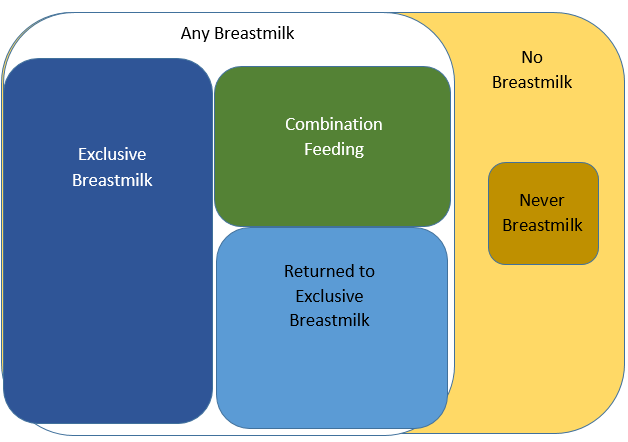Breastfeeding
within the infographics and these webpages refers to all methods of
providing breastmilk.
Breastmilk substitute
refers to any food that is used as a partial or total replacement for
breastmilk (mother or donor). Most breastmilk substitute is infant formula.
Supplementation
refers to any food or drink (e.g. expressed breastmilk, donor milk, glucose
water or infant formula) other than that received from the breast for the
purpose of adding to breastmilk received through feeding at the breast.
Initiation
refers to the time period from birth to hospital discharge for all live
births discharged home, or three days postpartum for home births.
Infant feeding
refers to feeding an infant by providing sustenance defined in the
categories below. In this report, infant feeding rates are measured at four
time points: initiation, two, four or up to six months. Infant feeding
intention rates are also measured in the prenatal period.
- Any breastmilk
: Infant is receiving any breastmilk. This can be exclusive breastmilk,
non-exclusive or returned to exclusive breastmilk.
- Exclusive breastmilk
: Infant is receiving, and has received only breastmilk since birth. This
includes expressed breastmilk and donor human milk.
- Non-exclusive breastmilk or Combination Feeding:
Infant is receiving breastmilk in combination with a breastmilk substitute,
whether medically indicated or not; or is receiving solid food in addition
to breastmilk.
- Returned to Exclusive breastmilk
:
-
At initiation: Infant received a breastmilk substitute at some point prior
to hospital discharge, but is receiving only breastmilk at discharge.
-
At two months or beyond: Infant received a breastmilk substitute at some
point prior to two months (including in hospital), but is receiving only
breastmilk at the time point.
- No breastmilk
: Infant is not receiving any breastmilk. This percentage plus the any
breastmilk percentage, equals 100% of infants.
- Never breastmilk
: Infant has never received breastmilk.
Adjusted Breastfeeding Rate at Initiation
: The number of infants who are exclusively breastfed, fed human milk
(maternal or donor) or received breastmilk substitute for documented
medical reasons, expressed as a percentage of all live births. This
indicator is noteworthy as it is provided to hospitals by BORN.
Venn Diagram of Infant Feeding Definitions
